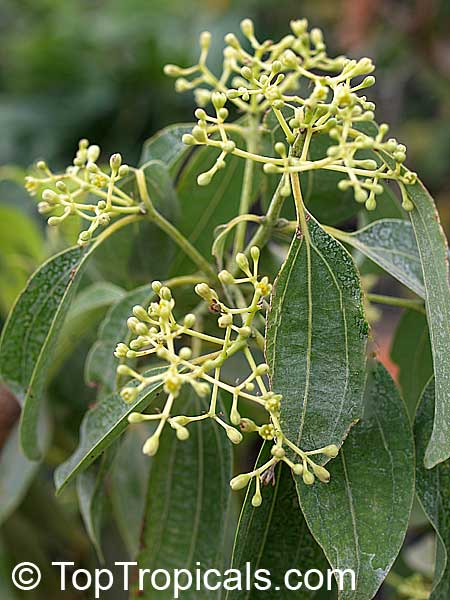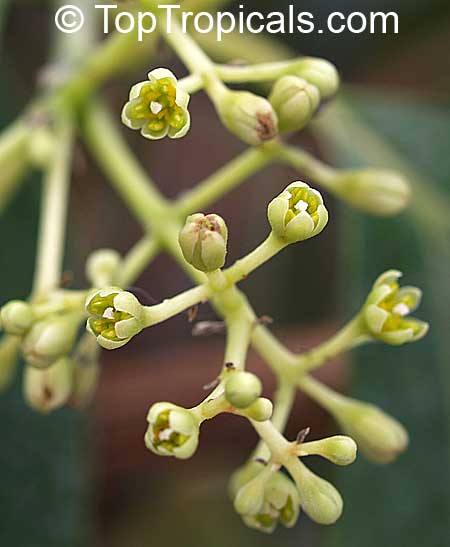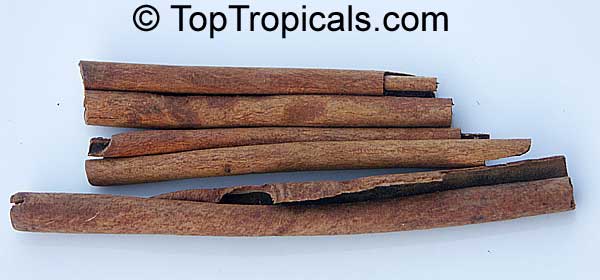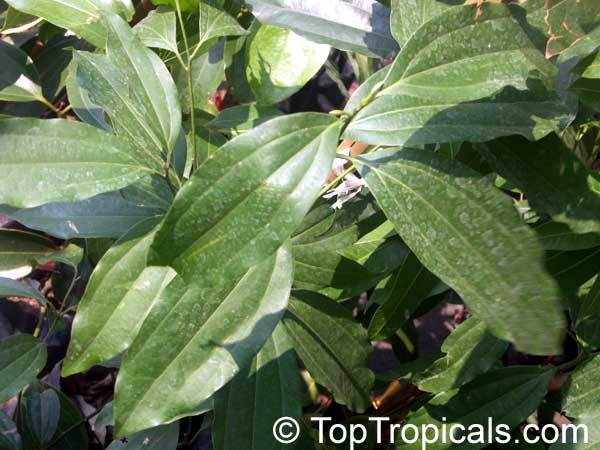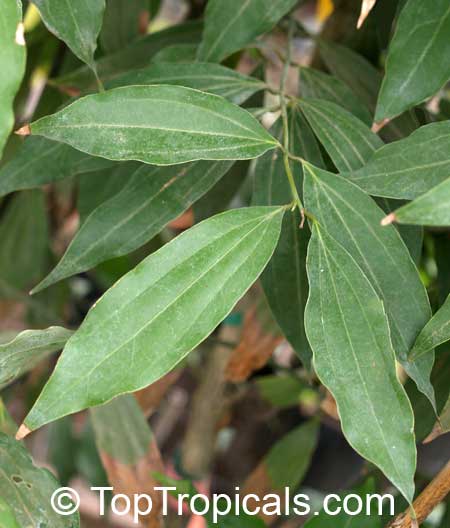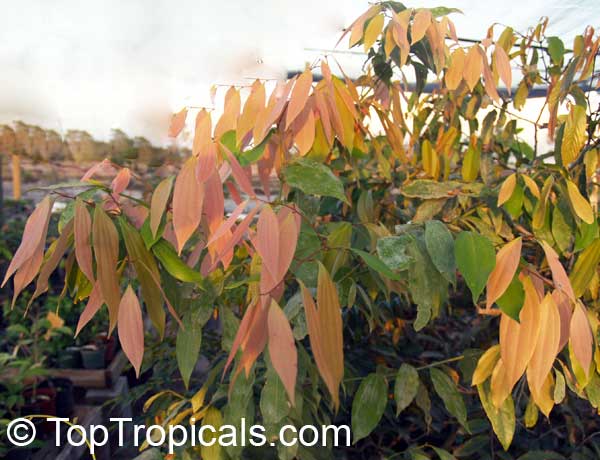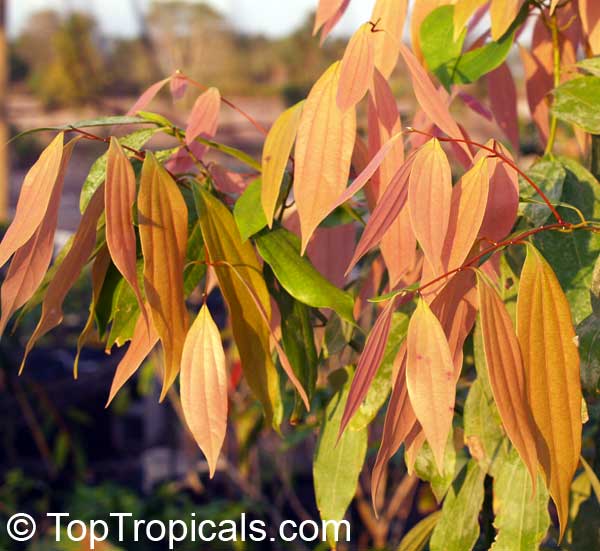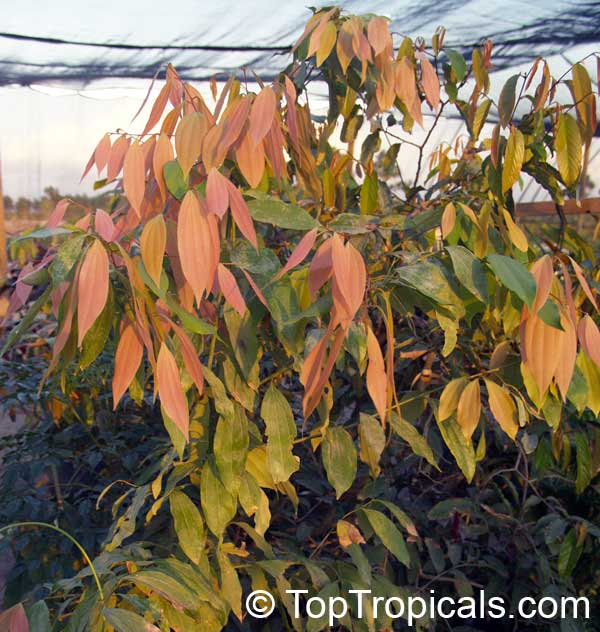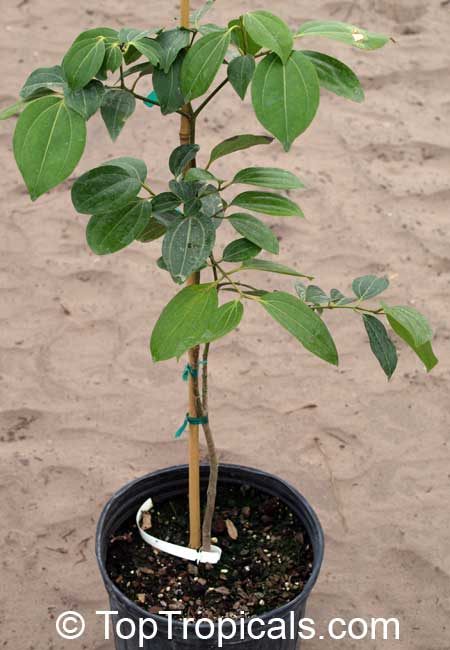Featured plant - a special for your collection
Cinnamomum zeylanicum - a legendary commodity and culinary spice
Scientific name: Cinnamomum zeylanicum, Cinnamomum verum
Family: Lauraceae
Common name: Cinnamon
Origin: Sri Lanka (Ceylon)
An exciting story of Cinnamon - the most famous world's spice... This historical plant can be easily grown in your garden. Enjoy the story and brew some cinnamon tea!..
Young leaves of Cinnamon can be pinkish to red
Somewhere in the archives of your mind, do you remember your school days and studying the great explorers of the New World, like Columbus and Magellan? Were you ever asked how and why these extravagant expeditions were funded? These ever-dangerous missions were the sixteenth-century prequel to the Cold War space race, with similar stakes for national prestige and power. In the days before NASA and government grants, who put up the cash for these escapades? It was usually the Spanish king. But, as you doubtless already know if you've ever tried coax a new office computer out of your boss, there never seems to be enough money in the budget. In contrast to the illusion of endless wealth they portrayed, even kings were often in deep financial straits, and competitors were fierce for the few funds they offered. And proving your soundness as a financial risk was no easy thing in those days before computerized credit reports.. As classics of political economics have taught us, capitalists can lend money only in exchange for profit. So, if you approached the king with a "go I know not whither” attitude, you had better at least promise to bring back something worthwhile was a perennially popular quarry, such as spices, which were often worth more their weight in gold.
Only one out of five ships from Magellan's fleet returned - the "Victoria". However, the hold carried 26 tons of spices, sufficient to cover the losses of the expedition and to actually make a profit for the investors.
Life in those days would have been unbearable without savory spices to disguise the poor quality and preparation of food. The quality of food was disgusting - unless you were royalty, you were destined for a lifetime of boiled meat-and-vegetable soup. The culinary arts existed more in theory than in fact, and only the rich could afford the luxury of fried meat (widespread consumption of fried meat did not come until the 18- and 19th centuries). Today we feed our dogs better meat than most people ate then, and salting was the only method of keeping meat fresh. Toil and harsh conditions were the standard of life... That's why spices were so valued, with their ability to lift the palate and the spirit even slightly above the drudgery of everyday life. Our sense of taste is primitive-- we sense saltiness, sweetness, bitterness and acidity, and in this we are not much different from other animals. Most of our culinary enjoyment stems from the sense of smell, which connects aromas to specific foods. Spices were also important as status: something akin to wearing a Rolex watch or owning a yacht.
In those times the spice trade route came by way of Muslim countries and from there by sea- through the Italian ports of Genoa and Venice. The fantastic wealth of these and other ports was almost completely due to the spice trade, or rather to the hefty customs duties collected on these goods. Without this excess wealth and the artistic patronage it inspired, the Renaissance would not have been possible (it is interesting to speculate on where we would be without it!). Everything was fine prior to the beginning of the fifteenth century, when the Turks took the Balkans, the Black Sea and Syria, ending the old commercial routes to the East. The developing countries of Europe were very unhappy with these circumstances. They began to cherish the idea of going directly to the source of the riches themselves, cutting out the middleman.. It was this prospect of grand profit which fueled the first risky expeditions. Perhaps one of the most crucial points in the history of commerce was May 20, 1498, when Vasco de Gama sailed to Calcutta, initiating “spice fever”!
Two countries, Spain and Portugal, were dearest to the Pope's heart at this time. They burned their heretics, unlike the more freethinking France and England. To the great dismay of Pope Alexander VI, by the end of the fifteenth century there was no love lost between these two rival siblings of the Pope's affections. Portugal mastered the route around Africa, and Spain (a little late on the exploration scene, as it was preoccupied with disarming the Moors), decided to move to other side, sending Columbus westward. They took different directions with the same intent-- to posses the riches of the Orient. The outcome is now legendary. In 1494, under the auspices of the Pope the world was divided in two: Spanish (to the West from the 49th meridian) and Portuguese (to the east). This agreement did not interfere with the existence of countries already established. It is interesting that this arbitrary division allowed Portugal to colonize Brazil, where Portuguese is spoken to this day.
Meanwhile other countries were not at rest and were no less greedy in their aspirations. England and Holland took their share colonies as well. For example, the Dutch East Indian company practically governed Indonesia and therefore monopolized world trade in spices from the 17th century on. English companies in India monopolized the perfume trade, and these are only two commodities that were plundered by empirical ambition.
Here we will discuss only one plant - cinnamon (Cinnamomum). Various varieties exist, only two of which are commercially popular: plain cinnamon - Cinnamomum zeylanicum, native to Ceylon and Malabar off the coast of India; and Cassia cinnamon - Cinnamomum aromaticum, native to Burma and South China (not to be confused the Cassia plant). The spice cinnamon is obtained from the young bark of the branches. The two differ in appearance in the fact that the bark of cinnamon is thin and yellowish-brown, and the bark of Cassia is thicker and gray in color. Cinnamon possesses the stronger aroma, but to deduce the form of the plant from the appearance of the spice is practically impossible.
The first references to Cassia are encountered in Chinese books dated about 3000 B.C. The Egyptian queen Hatshepsut, who ruled approximately 1500 B.C.,was an outstanding monarch, especially considering how rare it was for a woman to rule in those times. Among her accomplishments she organized an expedition into present-day Yemen to find valuable species of wood and ivory for the building of the palace and temple in Thebes. Among the treasures was a large quantity of cinnamon.
In the works of John the Apostle (Revelation 18:12-13, New International Version), cinnamon is mentioned among the “excesses” of the riches of Babylon:
...Cargoes of gold, silver, precious stones and pearls; fine linen, purple, silk and scarlet cloth; every sort of citron wood, and articles of every kind made of ivory, costly wood, bronze, iron and marble; cargoes of cinnamon and spice, of incense, myrrh and frankincense, of wine and olive oil, of fine flour and wheat; cattle and sheep; horses and carriages; and bodies and souls of men.
The Roman historian Pliny wrote that the cost of cinnamon was fifteen times that of silver. Romans used the spice to make expensive perfumery as well as to improve the taste of wine. Emperor Nero, after the murder of his wife, ordered cinnamon to be gathered from the entire city for the funeral bonfire.
Medieval Europe all but forgot about cinnamon, and only rare contacts with Muslims and Marco Polo's expedition revived the use of cinnamon and sugar in cooking. In the 15th century cinnamon was so expensive that it was paid for in Muslim markets with "hard currency"- eunuchs and white female slaves.
In the spring of 1530 The Holy Roman Emperor Charles V went to Germany to visit one of the richest bankers of Europe- Fugger. It was an unpleasant mission for the emperor- he was there to ask more time to pay old loans as well as to obtain new funds. Charles complained about the cold weather in Germany and compared it with the warm spring of Italy. In reply the banker threw cinnamon bark into the furnace, after first throwing in the old debts of the emperor- a gesture to show that Germans were at least warm of heart!
As previously discussed, the Portuguese and Spaniards rushed to the Spice Islands from either side. Lorenzo de Almeida discovered Ceylon and its cinnamon trees in 1505. Before this cinnamon was the source of wealth of rulers. In 1580 the Portuguese took the coast and required 125 tons of cinnamon as a yearly tribute from the natives.
In desperation the king of Candi (one of four kingdoms of Ceylon) turned to the Dutch for help, and in 1658 the island fell under the possession of the Dutchmen. However, their administration was no more merciful than the Portuguese- in fact it was much worse.
The men who harvested cinnamon belonged to one of the lowest castes - Chaliya. Each of them had to gather about 60 lb of cinnamon each season. Dutchmen raised this quota ten times that amount, a practically impossible amount. Then they freed the harvesters from taxes at least. Still, it is not surprising that many chose to run away into the mountains, increasing the burden on those remaining. And there was only one punishment for a fugitive caught- capital punishment. Capital punishment also awaited any who attempted to smuggle cinnamon or anyone who had unreported cinnamon trees on his property. When Dutchmen learned that the cinnamon grew on the Malabar coast of India, they persuaded local rulers by bribes and threats to destroy the trees in order to completely monopolize the market.
The majority of cinnamon was grown in the kingdom of Candi, and its rulers often destroyed trees in order to sabotage the Europeans. In 1761 they attacked the Dutchmen, killing about 7,000 people and destroying huge reserves of cinnamon. It is not surprising that the price of cinnamon in Holland leaped instantly. To prevent another such incident, the Dutch began to cultivate cinnamon on plantations. This arrangement was no more tasteful to the harvesters, who once again began to sabotage trees in protest. In response to this the Dutch imposed a severe punishment- anyone caught in sabotage had his right hand chopped off.
Plantations proved to be successful, and the collection of wild cinnamon ceased to be profitable. Breeding cinnamon trees led to the crisis of overproduction, and in June of 1760 in Amsterdam, a a cinnamon reserve worth 16 million French livre (an imposing sum in today's currency, one could buy a good horse for 100 livre that days) burnt in a building of the Admiralty over the course of two days. It was noted that for several days the entire land of Holland smelled of cinnamon.
When France took Holland after the French revolution, it also gained Ceylon. When England defeated the French in 1795, they put this resource to work immediately, putting the rich plantations under the control of the East India Company. The island was completely subject to England and the cultivation of cinnamon was sharply limited to drive the market. However, this monopoly collapsed to the middle of the nineteenth century due to the Dutch smuggling exported cinnamon trees to Java and Borneo, and Frenchmen revealed that the cinnamon also grew well on the islands of Maverick and Reunion.
All this led to the price of cinnamon falling drastically in Europe, allowing even the non-rich to use this spice which was previously reserved for only the most wealthy of diners.
Nowdays, world production of cinnamon is about 8,000-10,000 tons per year, with 80-90% of this coming from Sri Lanka. World production of cassia is 20,000-25,000 tons per year, two thirds of which is grown in Indonesia. Cinnamon and Cassia are used in the production of liqueurs, perfumery, and for cooking.
The cinnamon tree can reach 50 ft in height, but on plantations are trained into bushes of 6-8 ft. The leaves are fragrant (they are often used to impart a cinnamon flavor to tea, for example). The cinnamon tree "drinks" a large amount of water. In its natural habitat, more than 6 ft of rain fall annually. The flowers are very small and unimposing.
The cinnamon tree is propagated by seeds or cuttings. The plant is pruned after two or three years to form a bush, and cinnamon can already be harvested in the rainy season from a two-year old tree.
The harvesting method is relatively simple. First branches are cut from the tree. These are left for a day or two- in the dampness the bark rots, and becomes easier to separate from the tree. After this comes the most complex part of the operation. The twigs and leaves are trimmed from the branches and the outer rough layer of of bark is scraped off. After this, “stripes” are cut into the branches to separate the bark from the inner wood of the branch. The bark is then cut from the branch by making two accurate parallel cuts, and it then forms the characteristic curled twigs that we recognize as cinnamon sticks. These are then cut accurately into 42-inch lengths and dried.
One acre yields about 200 lb of cinnamon per year...
Cinnamon tree can be easily grown as an exotic container plant, or planted in ground in areas with frost free climate. Fresh leaves may be added to tea. Enjoy the aroma of this of this tropical plant collection gem!
Order the plant:
Cinnamon Tree (March 2007) is in 3 gal container

